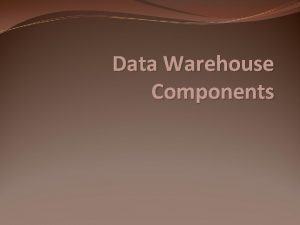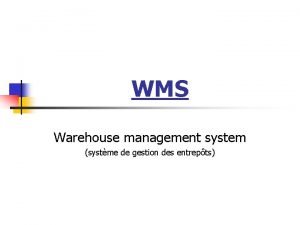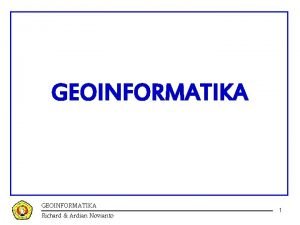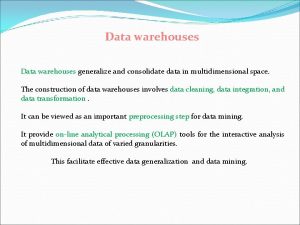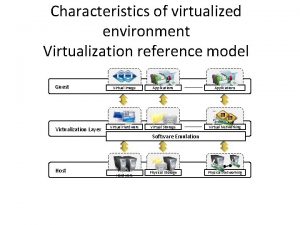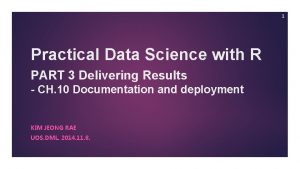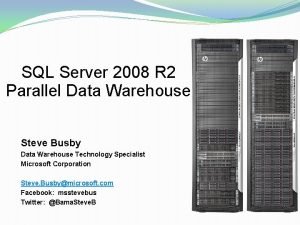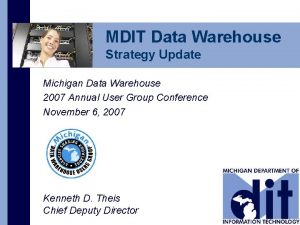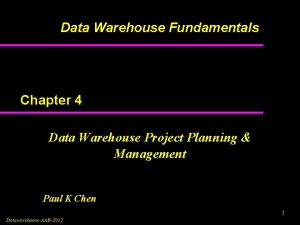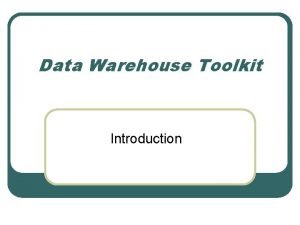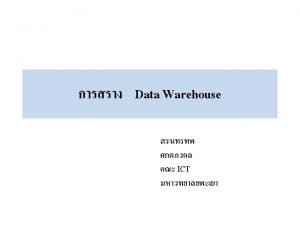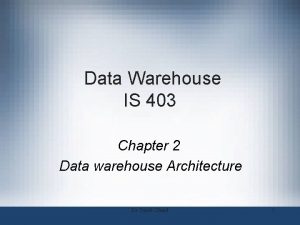Practical Space Management in Data Warehouse Environments Hamid



























































![De-Allocate Segment Free Space § Unused blocks. ALTER [TABLE | INDEX | CLUSTER] segment_name De-Allocate Segment Free Space § Unused blocks. ALTER [TABLE | INDEX | CLUSTER] segment_name](https://slidetodoc.com/presentation_image_h/81f97815b9232e691d76c842d7bcc742/image-60.jpg)
















- Slides: 76

Practical Space Management in Data Warehouse Environments Hamid Minoui Database Specialists, Inc. www. dbspecialists. com hminoui@dbspecialists. com 11/22/2020 1

Objectives § To point out data warehouse space management issues § Suggest resolutions § Recommend space management methodologies § Provide proactive prevention strategies § Cover both Oracle 9 i and Oracle 10 g space management features 11/22/2020 2

Characteristics of a Data Warehouse § The data: – – – – Large amount of data loads and ETL operations Very large size (Terabytes) Change in structure of source data Contains lots of historical data Data massaging and aggregations Multiple sources of data Dynamic nature of data 11/22/2020 3

Characteristics of a Data Warehouse (continued) § Maintenance activities: – – – Space management Table re-organizations Index rebuilds Partition maintenance Refresh maintenance on materialized views Job and scheduling management 11/22/2020 4

Characteristics of a Data Warehouse (continued) § Typical issues: – – – Data integrity issues Data security issues Space issues Query performance issues Duplicate rows 11/22/2020 5

Characteristics of a Data Warehouse (continued) § Database features frequently used: – – – – Materialized views (MV) Bitmap indexes and bitmap-join indexes Index organized tables (IOT) Parallel execution Table and index partitioning Table and index compression Load utilities and facilities 11/22/2020 6

Other Characteristics § § § § Star schemas, snow flakes or 3 rd Normal Form Have dimensions and hierarchy Frequent need to collect statistics Use of bulk and parallel loads Variety in the generated queries Dynamic nature of queries Divided into areas (staging, ODS, and target area) Often associated with smaller data marts 11/22/2020 7

Performance Tuning and Resolutions § § § Frequent query tuning Star transformation De-normalization Pre-aggregations via materialized views B*Tree, IOT, function based, bitmapjoin indexes § Use of database resource management 11/22/2020 8

Why is Space a Coveted Resource in a Data Warehouse? § § § § Lots of disk space is consumed Stores all enterprise data Segments are mostly large Many indexes Years of historical data kept online Many versions of the same data Duplicated and de-normalized data Various levels and dimensions of data (monthly, weekly, daily) 11/22/2020 9

Why is Space a Coveted Resource in a Data Warehouse? § Enough reserve space needed: – – – – For daily/weekly/monthly growth Recall offline old data when needed Data correction Materialized views and their growth Emergency needs Data files and tablespace growth Temporary tablespaces 11/22/2020 10

Reacting to Space Issues § Down sides: – Often, not enough time to react – Delay in the load – Wasted resources to reload § Up sides: – Loads are usually scheduled – Once data is loaded, most of it won’t change 11/22/2020 11

Issues with Database Backups in a Data Warehouse § § Too many files to backup every night Backup takes a long time to complete System resources busy during backup Possible licensing issues with third-party backup software § Restoring and recovery after a failure can take a long time 11/22/2020 12

A Typical Backup Strategy § Make non-current table spaces READONLY every month § Perform a special backup of READONLY tablespaces § Exclude the READONLY table spaces from regular hot backups § Never backup temporary tablespaces Caveat: You must wait until all transactions are committed 11/22/2020 13

Avoiding Unnecessary Redo Log Generation § Create some tables and all indexes with NOLOGGING for any segment that can be regenerated without doing a database recovery: • SQL*Loader with direct path load • CREATE TABLE AS SELECT from external or transient tables • INSERT using +append hint • Use global temporary tables insert /* +append */ into transiant_table select * from source_table ; 11/22/2020 create table transient_table as select * from source_table ; 14

Speeding Up Bulk Load Operations § Before the load: – Make all non-unique indexes unusable – Disable the primary and unique constraints if the source data is trusted – Disable all triggers on the table – Set the session to skip unusable indexes 11/22/2020 15

Speeding Up Bulk Load Operations § Implement the load: – Use append and parallel hints with insert – Commit the transaction § After the load: – Rebuild indexes – Enable triggers and constraints 11/22/2020 16

Space Issues in Data Warehouses § Permanent tablespaces (data, indexes) § Temporary tablespaces (temp segments) § UNDO segments and tablespace 11/22/2020 17

Space Issues with Permanent Tablespaces § Caused by: – – – Poor extent sizing Setting maxextents PCT_INCREASE > 0 Small data files (tablespaces) User quota on tablespace 11/22/2020 18

Space Issues with Temporary Tablespace § Caused by: – Not enough space for the sort segments – Other temp segments such as global temporary tables – Multiple users sharing the same temporary space – Multiple queries with sort requirements running at any time 11/22/2020 19

Space Issues with Temporary Tablespace § Partially resolved by: – Oracle 9 i - Dynamic PGA memory allocation • PGA_AGGREGATE_TARGET=<integer value> • WORKAREA_SIZE_POLICY=AUTO – Oracle 10 g - Tablespace Group assignment 11/22/2020 20

Space Issues Associated with Undo Segments § Long running queries causing ORA-1555 (snapshot too old) § Small UNDO tablespace § Small rollback segments 11/22/2020 21

Database Block Size (DB_BLOCK_SIZE) § Should seriously be considered § An important decision with new data warehouse projects § Inappropriate value can be disastrous and detrimental § Small value can: – Impact I/O efficiency for majority of queries – Negatively influence overall database performance 11/22/2020 22

Appropriate DB_BLOCK_SIZE Value § Multiple of the OS block size § As large as your I/O subsystem can handle in a single read § As large as supported by Oracle § Best benefit from larger block size if: – Database is configured on raw devices, or – Direct I/O is available to you. 11/22/2020 23

Benefits of Larger DB_BLOCK_SIZE Value § Efficiency with index scan – A larger block size reduces the number of reads required to probe an index and scan a range of values from its leaf blocks § Less memory requirement for buffer cache – Fewer buffers needed for index branch blocks § Better compression ratio for tables, indexes § Improvement in block density – Amount of space used by fixed portion of bock header is reduced 11/22/2020 24

Benefits of Larger DB_BLOCK_SIZE Value § Blocks can accommodate longer rows; less chance for row chaining § Less occurrence of ORA-1555 – Increase in size of the transaction table in undo segments header blocks § Fewer writes required for data loads – Because of the reduced block level overhead, less redo logs are generated when blocks are modified sequentially 11/22/2020 25

Disks, I/O and Database Files Configuration § A poorly configured I/O subsystem can badly impact I/O performance § Poor I/O performance can impair a data warehouse § Configure disk and distribute data for read and write efficiency § Use raw I/O if possible, otherwise use direct I/O § Make use of asynchronous I/O, parallel read and parallel writes 11/22/2020 26

Disks, I/O and Database Files Configuration § Stripe and Mirror or Mirror and Stripe the disks – RAID-1+0 or RAID-0+1 § Evenly spread your data and Stripe And Mirror Everything (SAME) on many disks § Reserve room on file systems for auto extendable files 11/22/2020 27

Managing the UNDO Segments § Manual undo (rollback segments) management – Pre Oracle 9 i practices – Too many manual interventions by DBA 11/22/2020 28

Managing UNDO (continued) § Automatic Undo Management (AUM) – Much better – Highly recommended – Allows controlling retention of committed transactions undo information (UNDO_RETENTION) – Better monitoring statistics – Infrequent occurrence of ORA-1555 – SMON periodically manage space and shrinks undo segments 11/22/2020 29

UNDO_RETENTION Parameter Setting § Set to a value equal to the time used by the longest running query § Undo is ‘expired’ when retention time is reached § Expired undo will be de-allocated if needed by new transactions § Unexpired undo are re-used if space is needed (undo reuse) § Default value is 300 seconds 11/22/2020 30

Undo Reuse and Undo Stealing § Undo Reuse: Unexpired undo of the same segment will be reused § Undo Stealing: Unexpired undo of another segment is used § Undo reuse is more common. Occurs when – UNDO tablespace is too small, or – UNDO_RETENTION value is too large 11/22/2020 31

Monitoring the UNDO Segments Statistics § Statistics are gathered in V$UNDOSTAT every 10 minutes § Helps sizing UNDO tablespaces and tune UNDO_RETENTION § Statistics are retained for 7 days 11/22/2020 32

V$UNDOSTAT BEGIN_TIME Beginning time for this interval END_TIME Ending time for this interval UNDOTSN Tablespace ID of the last active undo within the interval UNDOBLKS Number of consumed undo blocks within the period MAXQUERYLEN The longest length of time (in seconds) a query took to complete within this period TXNCOUNT Total number of transactions executed with the period 11/22/2020 33

V$UNDOSTAT (continued) UNXPSTEALCNT Number of attempts to obtain undo space by stealing unexpired extents from other undo segments UNXPBLKRELCNT Number of unexpired blocks released from undo segments to be used by other transactions SSOLDERRNT Number of times ORA-1555 occurred with the period NOSPACERRCNT Number of times space was unavailable in the undo tablespace when requested and failed 11/22/2020 34

Tuning UNDO_RETENTION § Oracle 9 i: – Manually adjust to the time taken by the longest query SELECT MAX (MAXQUERYLEN) FROM V$UNDOSTAT; § Oracle 10 g: – Automatically tracked and tuned by RDBMS 11/22/2020 35

The UNDO Tablespace § Created at DB creation or with CREATE UNDO TABLESPACE § Use V$UNDOSTAT for sizing and monitoring § Space issues if UNDO_RETENTION is too large § Use AUTOEXTEND § RETENTION_GUARANTEE clause § Sizing formula: Undo Segment Space Required (MB) = (undo_retention * undo_blcks/secs * DB_BLOCK_Size)/1024 11/22/2020 36

Database Fragmentation Issues § Best to reduce or eliminate fragmentation to avoid wastage and improve performance – Tablespace level (or file level) fragmentation – Segment level fragmentation – Block level fragmentation 11/22/2020 37

Tablespace Level Fragmentation § Bubble Fragmentation – Free block of space not large enough for another extent § Honeycomb Fragmentation – Free un-coalesced space next to each other but considered separate 11/22/2020 38

Segment Level Fragmentation § Space allocated to segment is not fully utilized (wasted) – Space above the high water mark (unused blocks) – Free segment blocks below the high water mark 11/22/2020 39

Block Level Fragmentation § Blocks are not empty but there is space within a block that is not used § Caused by: – Setting of PCTFREE and PCTUSED – Deletions – Row migrations 11/22/2020 40

Tablespace Planning § Use locally managed tablespaces (LMTs) with UNIFORM size extents – 64 K bitmaps on file header are used to manage extents – Improves performance and significantly reduces overhead associated with updating dictionary tables (recursive SQL) – No need to use ST enqueue – No more tablespace fragmentation 11/22/2020 41

Tablespace Planning § Use Automatic Segment Space Management (ASSM) – Set at the tablespace level – Tablespace must be locally managed – Uses bitmap instead of freelist to manage space within segments 11/22/2020 42

Benefits of ASSM § No more need for FREELISTS, FREELIST GROUPS and PCTUSED § Reduces segment level and block level fragmentations § Reduces the number of buffer free waits § Adds efficiency to space usage § Provides better use of space within the blocks 11/22/2020 43

LMT Considerations § The bitmap is 64 K – Make the size of each file a multiple of UNIFORM extent+64 K § Storage parameters – Avoid setting them – If already defined on segments reorganize, or rebuild with storage parameters matching tablespace 11/22/2020 44

Multiple Tablespace Size Models § SAFE (methodology) § Group segments according to size (3 groups) § Use 3 tablespace model having different UNIFORM extents § Assign each group to one of the size model § Develop a naming convention Segment Size Extent Size Model < 128 M 128 KB Small >= 128 M & < 4 GB 4 MB Medium 128 MB Large 11/22/2020 >= 4 GB 45

Tablespaces for Different Types of Segments § Separate indexes and tables – Better manageability – Different type of usage – Reduces wastage (indexes are rebuilt often in data warehouses) 11/22/2020 46

Adjust Settings of PCTFREE and PCTUSED Parameters § Avoid using default values § Set according to usage § Most of the times PCTFREE=0 and PCTFREE=99 should be enough § If ASSM, no need for PCTUSED § More compact data in blocks reduces waste and improves I/O 11/22/2020 47

Use Index Organized Tables (IOTs) § § When most of the columns are indexed When associated tables are used Columns are pre-sorted Makes better use of space and improve performance § Good for certain data warehouse tables 11/22/2020 48

Table Compression – Introduced in Oracle 9 i R 2 – Improves read only operations and factors out repetitive values within a block – Replaces duplicate values in a block with a reference to a symbol table in the block – Very low CPU overhead to reconstruct the block – Significantly fewer blocks, leading to better I/O – Very flexible (not all blocks are compressed) – Associated with bulk load operations 11/22/2020 49

Table Compression § To compress a table use: ALTER TABLE t 1 MOVE compress; § To compress a table partition use: ALTER TABLE T 1 MOVE PARTTION P 1 compress; § Alternative way CTAS compress: CREATE TABLE T 1 compress AS SELECT * FROM T 1_UNCOMPRESSED; § Table or partition not available (locked) during move § Use DBMS_REDEFINITION for online move 11/22/2020 50

To Get the Best Results § To achieve the best compression ratio: 1. Analyze the table to get column statistics SELECT COLUMN_NAME, NUM_DISTINCT, NUM_NULLS, AVG_COL_LEN FROM DBA_TAB_COLUMNS ; 2. Identify best candidate columns for sorting as columns with • • • Lowest number of distinct values (low NUM_DISTINCT) Least amount of null values (low NUM_NULLS) Longest average length (high AVG_COL_LEN) 3. CTAS compress and use order by candidate_column 11/22/2020 51

Table Compression Limitations § § Can not be used on LOB field Can not be used for IOTs Can not compress tables with bitmap indexes With Oracle 9 i, cannot drop or add columns to compressed tables 11/22/2020 52

Index Key Compression § Introduced in Oracle 8 i § Compression of leading index columns § Indexes are grouped into a suffix and prefix entry – Suffix entry made out of unique pieces – Prefix entry consist of the grouping piece § Can offer significant space savings and better I/O performance 11/22/2020 53

Index Key Compression Example § Current year’s Car Inventory table, index CAR_IND indexes columns are: Type, Color, Model § Before compression: <SUV><Black><Rock Climber> <Sedan><Blue><Charisma> <SUV><Black><Jungle Cruiser> <Sedan><Blue><Fantasy> <SUV><Black><Mountaineer> <Sedan><Blue><Starlet> …. … 11/22/2020 54

Index Key Compression Example (continued) § ALTER INDEX CAR_IND compress 3; § After compression: <SUV><Black> <Rock Climber> <Jungle Cruiser> <Mountaineer> <Sedan><Blue> <Charisma><Fantasy><Starlet> …. 11/22/2020 55

Index Key Compression § § § Partitioned indexes cannot be compressed Bitmap indexes cannot be compressed Can be defined on IOT Slight CPU overhead during index scan Consumes much less space Increases I/O throughput and buffer cache efficiency § Ideal for data warehouses 11/22/2020 56

Identifying Keys to Compress 1. Validate or analyze the index VALIDATE INDEX INDX 1; 2. Query the index_stats view SELECT NAME, OPT_CMPR_COUNT, OPT_CMPR_PCTSAVE FROM index_stats; 3. Examine output NAME ------INDX 1 11/22/2020 OPT_CMPR_COUNT -------2 OPT_CMPR_PCTSAVE -----------57 57

De-Allocating Unused Space § Segment Level: – Blocks above the segment high water mark (unused blocks) – Space below the segment high water mark (free blocks) § Tablespace Level – Free space within tablespace – Data file level – Unallocated space above the highest allocated extent (file high water mark) 11/22/2020 58

Identify Segment Space Usage § DBMS_SPACE. UNUSED_SPACE – Information about amount of unused space in segment and position of high water mark § DBMS_SPACE. FREE_BLOCKS – Information about the number of blocks on the freelist groups § DBMS_SPACE_USAGE – Information about the space usage of blocks under the high water mark 11/22/2020 59
![DeAllocate Segment Free Space Unused blocks ALTER TABLE INDEX CLUSTER segmentname De-Allocate Segment Free Space § Unused blocks. ALTER [TABLE | INDEX | CLUSTER] segment_name](https://slidetodoc.com/presentation_image_h/81f97815b9232e691d76c842d7bcc742/image-60.jpg)
De-Allocate Segment Free Space § Unused blocks. ALTER [TABLE | INDEX | CLUSTER] segment_name DEALLOCATE UNUSED [KEEP n. K ] – De-allocates only space above segment high water mark, retaining space specified by KEEP § Other Unused space–Pre Oracle 10 g – Reorganize table, rebuild index • Table move, export/import, DBMS_REDEFINITION interface) –Oracle 10 g – Online segment shrink 11/22/2020 60

Two-Phase Online Segment Shrink § ALTER TABLE table SHRINK SPACE; – Phase 1: • A series of DELETE and INSERT statements applied to move data to the beginning of the segment • DML-compatible changes are held on rows and blocks – Phase 2: • High water mark adjusted to the appropriate location. • Exclusive lock is held • Unused blocks (above high water mark) are de-allocated 11/22/2020 61

One-Phase Online Segment Shrink § ALTER TABLE table SHRINK SPACE COMPACT; § With COMPACT keyword only the first phase is executed. § To implement phase 2, issue it without COMPACT keyword at a later time 11/22/2020 62

One-Phase Online Segment Shrink (continued) § Restrictions – Row movement must be enabled – Triggers based on ROWID of table must be disabled § In data warehouses, locking might not be a problem on some tables 11/22/2020 63

De-allocating Space at the Tablespace Level § Caused by tablespace fragmentation – Index rebuilds, table moves, partition move, etc. – Not having UNIFORM size extents 11/22/2020 64

De-allocating Space at the Data File Level § File size larger than the last block used in the file § Size over-estimated § Auto extended 11/22/2020 65

Shrinking Data Files The statement: ALTER DATABASE DATAFILE ‘file_name’ resize n (K | M); – Attempts to size the data file to exactly n K (or M) – It is safe. It will fail with ORA-03297, if there are blocks of data beyond the requested resize value ORA-03297: File contains nnn blocks of data beyond requested resize value. 11/22/2020 66

Steps to Shrink Data Files to High Water Mark Position 1) Create a temporary table preferably a GTT CREATE global temporary table SPACE_ADMIN_GTT ON COMMIT PRESERVE ROWS AS SELECT FILE_NAME, TABLESPACE_NAME, BYTES, BYTES FROM DBA_DATAFILES WHERE 1=0; 2) Create another table with name of tablespace to shrink CREATE GLOBAL TEMPORAY TABLE SHRINKING_TBS_GTT ON COMMIT PRESERVE ROWS AS SELECT TABLESPACE_NAME FROM DBA_TABLESPACES WHERE TABLESPACE_NAME in (‘TBS 1’, ’TBS 2’, ’TBS 3’); COMMIT; 11/22/2020 67

Steps to Shrink Data Files to High Water Mark Position (continued) 3) Get DB_BLOCK_SIZE column value new_val blksize select value from v$parameter where name = 'db_block_size' ; 11/22/2020 68

Steps to Shrink Data Files to High Water Mark Position (continued) 4) Calculate the file’s high water mark and save INSERT INTO SPACE_ADMIN_GTT SELECT file_name, tablespace_name, ceil( (nvl(hwm, 1)*&&blksize)/1024 ) smallest, ceil( blocks*&&blksize/1024) currsize, ceil( blocks*&&blksize/1024) ceil( (nvl(hwm, 1)*&&blksize)/1024 ) savings FROM DBA_DATA_FILES a, ( SELECT file_id, max(block_id+blocks-1) hwm FROM DBA_EXTENTS GROUP BY file_id ) b WHERE a. file_id = b. file_id(+) AND a. tablespace_name IN (SELECT tablespace_name FROM SHRINKING_TBS_GTT) ; COMMIT; 11/22/2020 69

Steps to Shrink Data Files to High Water Mark Position (continued) 5) Generate ALTER DATABASE commands column cmd format a 95 word_wrapped set trimspool on SPOOL c: TMPdbf_resize. sql SELECT 'alter database datafile '''||file_name||''' resize ' || smallest || 'm; ' cmd FROM SPACE_ADMIN_GTT WHERE savings >= 5 ; SPOOL OFF 11/22/2020 70

Automatically Resolving Space Issues § Oracle 9 i Feature called RESUMABLE SPACE ALLOCATION § Allows an active session to be suspended if a space issue is encountered § The session resumes automatically when – Space issue is fixed – A timeout period (default: 2 hours) is reached § Beneficial for data warehouse environments 11/22/2020 71

Steps for Resumable Space Allocation 1. DBA grants RESUMABLE privilege to user 2. User makes session resumable with ALTER SESSION ENABLE RESUMABLE ; 3. If session encounters space problem, it is suspended 11/22/2020 72

Steps for Resumable Space Allocation 4. If AFTER SUPSPEND TRIGGER exists, it gets executed 5. If trigger does not exit (or disabled) or if the trigger does not fix the space problem, session remains suspended 6. Session resumes when space problem is fixed or timeout value is reached 11/22/2020 73

Other Helpful Space-Related Features § Oracle-Managed Datafiles (OMF) § DBA_ADVISOR family of views § Oracle 10 g Workload Repository (AWR) and segment advisor § Oracle 10 g Grid Control for monitoring 11/22/2020 74

Conclusion § Oracle is consistent in offering new space management related features in every release § Should be used by DBAs for best practices § They enhance performance, reduce waste, improve availability, reduce frequency of failures, and provide better monitoring § Data warehouse operations that rely heavily on space and I/O performance benefit the most from these features 11/22/2020 75

Contact Information Hamid Minoui Database Specialists, Inc. 388 Market Street, Suite 400 San Francisco, CA 94111 Tel: 415/344 -0500 Email: hminoui@dbspecialists. com Web: www. dbspecialists. com 11/22/2020 76
 Data mining in data warehouse
Data mining in data warehouse Contoh data mart
Contoh data mart Building blocks of data warehouse
Building blocks of data warehouse Apa yang dimaksud dengan data mart
Apa yang dimaksud dengan data mart Introduction to data warehouse
Introduction to data warehouse Data warehouse dan data mining
Data warehouse dan data mining Data mining dan data warehouse
Data mining dan data warehouse Olap data mining
Olap data mining What is data acquisition in data warehouse
What is data acquisition in data warehouse Prinsip data warehouse
Prinsip data warehouse Rolap architecture
Rolap architecture Data warehouse dan data mining
Data warehouse dan data mining Analitical cubism
Analitical cubism Wms définition
Wms définition Warehouse capacity formula
Warehouse capacity formula Warehouse space reynosa
Warehouse space reynosa Sekai technology
Sekai technology Sekai technology
Sekai technology Hamid khattak
Hamid khattak Hamid vakilzadian
Hamid vakilzadian R4funds
R4funds Hamid vazin
Hamid vazin Alia hamid
Alia hamid Hamid rahim
Hamid rahim Ardian shajkovci
Ardian shajkovci Seyed hamid reza sanei
Seyed hamid reza sanei Hamid mahini
Hamid mahini Hamid yeşilyayla
Hamid yeşilyayla Hamid d. ismail
Hamid d. ismail Lovostatin
Lovostatin Hamid harroud
Hamid harroud Hamid yunis
Hamid yunis Dr hamid rabiee
Dr hamid rabiee Doc zainul abidin hamid
Doc zainul abidin hamid Hamid zolfaghari
Hamid zolfaghari Hamid sebaly
Hamid sebaly Hamid rashid finterra
Hamid rashid finterra Edy suandi hamid
Edy suandi hamid Edy suandi hamid
Edy suandi hamid Mbbsch
Mbbsch Data warehouses generalize and consolidate data in space.
Data warehouses generalize and consolidate data in space. International business environment and operations
International business environment and operations Virtualization reference model
Virtualization reference model Busniess goals
Busniess goals Chapter 13 natural environments of europe
Chapter 13 natural environments of europe Stable prediction across unknown environments
Stable prediction across unknown environments Psychologically informed environments
Psychologically informed environments Psychologically informed environments
Psychologically informed environments Creating supportive environments smoking
Creating supportive environments smoking High quality supportive environments
High quality supportive environments External environment and accountability of schools
External environment and accountability of schools Example of model-based agent
Example of model-based agent Chapter 13 natural environments of europe
Chapter 13 natural environments of europe Designing constructivist learning environments
Designing constructivist learning environments World geography
World geography Why are cold environments under threat
Why are cold environments under threat Micro market and macro environment
Micro market and macro environment Ibm spectrum protect competitors
Ibm spectrum protect competitors Marketing environment definition
Marketing environment definition Information-intensive operating environments
Information-intensive operating environments Different environments
Different environments What is global marketing environment
What is global marketing environment International business environments and operations
International business environments and operations Diverse learning environments survey
Diverse learning environments survey Enabling environments eyfs
Enabling environments eyfs International business environments and operations
International business environments and operations Exercise in hot and cold environments
Exercise in hot and cold environments International business environments and operations
International business environments and operations Diverse learning environments survey
Diverse learning environments survey Practical data science with r github
Practical data science with r github Pivot diagram visio
Pivot diagram visio Collier county schools data warehouse
Collier county schools data warehouse Parallel data warehouse sql server 2012
Parallel data warehouse sql server 2012 Northwind data warehouse
Northwind data warehouse Epm data warehouse
Epm data warehouse Olam in data mining
Olam in data mining Mount sinai data warehouse
Mount sinai data warehouse


